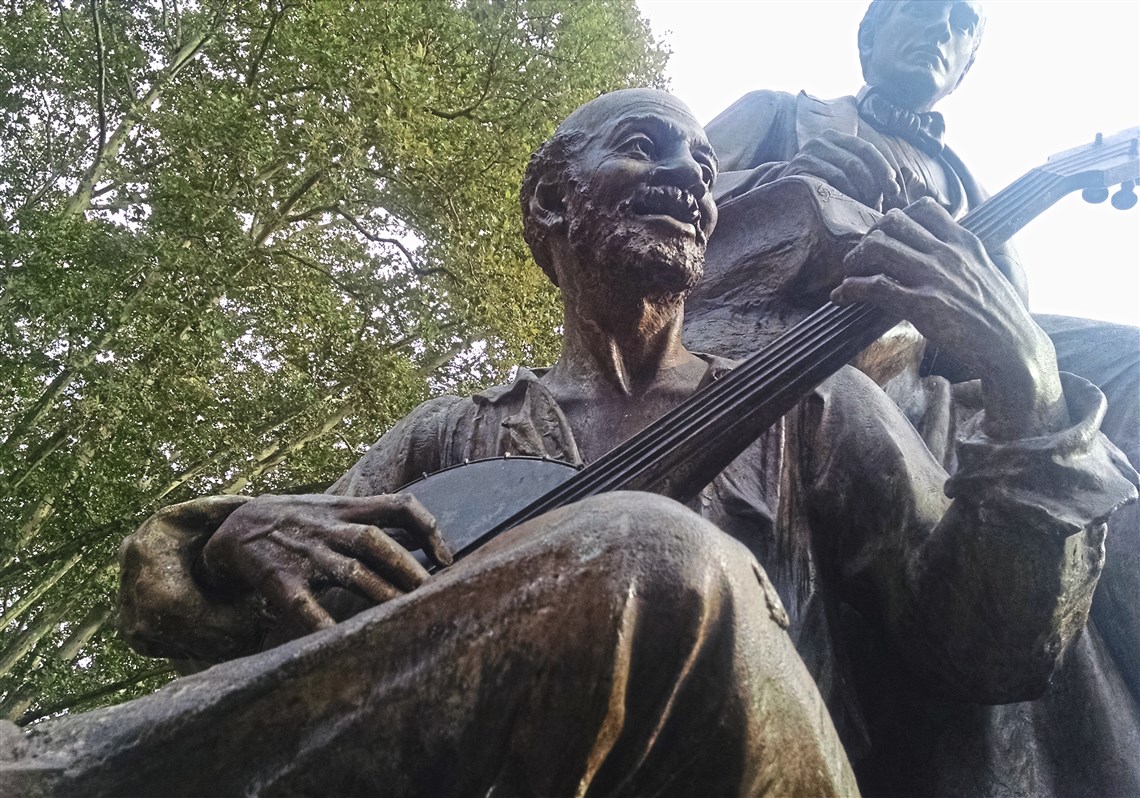Over 150 years since his death, scholars and musicians still argue about the racial legacy of Pittsburgh native Stephen Foster. But to many observers, the issues surrounding Foster’s 10-foot-statue on Forbes Avenue are somewhat more clear-cut.
“It’s the single most offensive display of public art in Pittsburgh, hands down,” said Paradise Gray, a hip-hop activist, musician and writer. “It permanently depicts the black man at the white man’s feet.”
While sculptor Giuseppe Moretti depicted Mr. Foster seated on a perch with a visionary cast, the shoeless banjo player at his feet — identified as “Uncle Ned” after one of Foster’s songs — stares vacantly. Even the sunny assessment that Foster is taking inspiration from African-American culture angers Mr. Gray.
“He’s doing what the music industry does today: He’s got a slave playing the music, and he’s going to end up with the copyright.”
But after more than a century and countless complaints, the music may be just about over for the city-owned Foster statue. A task force led by the University of Pittsburgh has been pondering its fate, and the city’s Art Commission, to which Mr. Gray was appointed by Mayor Bill Peduto in 2015, is poised to weigh in. (Mr. Gray later stepped down from the commission for health reasons.)
“The mayor would like the experts to come up with a recommendation,” said city spokesman Tim McNulty. He said the commission would likely take up the matter — with input from the task force and the community — within the next month.
Controversy over the statue, while nothing new, was rekindled after last weekend’s violent march by white supremacists in Charlottesville, Va., where a statue of Confederate General Robert E. Lee was a flashpoint. Since then, communities nationwide have been reassessing the messages sent by their own statuary. Scrutiny of the Foster memorial has flared up in social media, and in a story in the online publication The Incline.
But Mr. McNulty said that while the violence in Charlottesville “may have brought it to the forefront for some people, we’ve been working on this for awhile.”
Foster’s musical relationship to African-Americans is complicated, said Deane Root, a music professor at the University of Pittsburgh and director of its Center for American Music.
“He was the first songwriter to put enslaved people into his songs — texts that made them much less a caricature,” Mr. Root said. W.E.B. DuBois, a black writer and civil-rights activist, hailed Foster’s music, and one of Foster’s lifelong friends, Charles Shiras, was a noted abolitionist.
But Foster “used the language of the time, which was racist [and] hurtful and damaging,” Mr. Root said. “There are songs I can’t look at, even though I have to as a historian.”
And while Foster’s best work may humanize African-Americans, “The statue is not the rendering of someone with human characteristics that we hear in his lyrics.”
Less than two dozen of Foster’s 250 compositions, which include songbook favorites like “Oh! Susannah” and “Camptown Races,” feature slaves. Yet much of white Pittsburgh supported the statue that included one.
Pittsburgh Press editor T.J. Keenan Jr., whose paper campaigned for public donations to the statue, proposed depicting Foster as “catching the inspiration for his melodies from the fingers of an old darkey reclining at his feet.” Work was supervised by a committee including city leaders like banker Andrew Mellon and political boss Christopher L. Magee.
Schoolchildren, meanwhile, contributed their pennies toward the project, and when the statue was dedicated in 1900, some 3,000 were on hand to sing Foster’s compositions. (Originally installed in Highland Park, the statue was moved to Oakland in 1944 after vandals repeatedly stole the banjo and a pencil from Foster’s hand.)
The Foster statue is not the only case in which racial tensions lie in plain sight. A handful of Oakland streets — Neville, McKee, Craig — are named after former slave owners. And in nearby Schenley Park, protests on behalf of native peoples have been held at a 30-foot-tall statue of Christopher Columbus, which also has been vandalized repeatedly.
“With public monuments, there’s both the question of who or what is being commemorated, and the issue of how it’s done,” said Kirk Savage, a University of Pittsburgh scholar on public art. While controversy around the Columbus statue turns on the first question, he said, “In the case of Foster, it’s the ‘how’ question much less than ‘who.’”
The statue was among the nation’s first depictions of an African-American in public sculpture, Mr. Savage said. “But it was the only image of a black person in an outdoor setting in Pittsburgh. And that’s terrible. You have [Foster] looking pensive, and then this barefoot, snaggle-toothed, balding, raggedly dressed figure. When you set up that comparison, it’s really evil.”
“I’m the type of person who tries not to let racist, classist, sexist strings pull me away from my brothers and sisters from different backgrounds,” agreed Ricardo Iamuuri Robinson, a Garfield-based sound artist. “But I can’t deny that it is a representation that gets under my skin. When something like this is in a public space, it’s an obvious degradation that some parents have to explain to your children. ”
Mr. Iamuuri Robinson is currently developing an art project which would feature a live banjo concert at the statue with original compositions written “from the perspective of Uncle Ned. I’m working on songs to share the perspective that this is a pretty honest sculpture as far as articulating power relationships. But I was going to tap into Uncle Ned’s humanity and explain his discontent.”
As an artist, Mr. Iamuuri Robinson said, “I’m not one of the people who wants to tear down artwork. But I would relocate it out of the public sphere and into a place where people have a choice and can confront that history on their own terms. A lot of people walk past that statue and feel nothing, but it is an imposition on a particular community.”
Mr. Savage said he and other instructors have used the statue in class. “I’ve had students put up a new plaque on it, with an inscription about racism. These monuments can create constructive dialogue, but then I”m a white person — I don’t have to deal with being demeaned every day.”
Kilolo Luckett, a member of the art commission, said, “My position on it as a college student at Pitt still remains: it must be removed from the public. No words, as an amendment to the statue, can provide context to explain away the racial imagery on display. Instead it will only reinforce myth-making and white supremacy.”
Mr. Savage, like Mr. Root, is part of a working group that has been meeting for months to discuss the statue’s fate. Led by Pitt’s Office of Diversity and Inclusion, participants include scholars, city officials, and students. Members offered mixed views on what should be done with the statue, though there appears to be little appetite for leaving it as is.
“What is placed on public property is an indication of what a place values,” said Renee Piechocki, a working group member and director of the Greater Pittsburgh Arts Council’s office of public art.
“When we have imagery that is painful and derogatory and racist, it hurts everyone.” She said she favored “a process to remove the work from public property,” though she declined to say what she thought should be done with the statue.
Mr. Root said he is generally “not in favor of taking down public art,” but says the statue has “no interpretation at all. I’d like to explain a lot of these issues,” while perhaps “balancing” it with a sculpture of a black Pittsburgh hero like 19th-century black newspaper editor Martin Delaney.
Indeed, said Mr. Gray, the arts commission member and activist, while it was “never too late” to address injustice, “there’s nothing new about this.”
“Charlottesville is white America’s wake-up call,” he said, emphasizing the word “white.” By contrast, he said, African Americans “have been going through this for 400 years.”










You need to be a member of Pittsburgh Jazz Network to add comments!
Join Pittsburgh Jazz Network